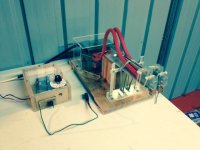I think this design is better.
I found it , in the german pedelec-forum.
Elegant and simple.
They adjust the amount of energy during the welding, by the amount of energy stored in the capacitor, by setting the voltage and size of the capacitor. Then you only need a regulated power supply, a big switch, and big wires/ electrodes to release the energy.
A big Schütz from an fork lifter worked fine. Albright SW200
https://www.youtube.com/watch?v=5TOzSjqydCY#t=14
They get good results about 1F 9-16V
Looks easy, and I think it is, but keep in mind they are working with a few hundreds Amps, “only 2-3 ms” enough for some serious damage of your eyes fingers...
So don't do it.
If you do it.
Wear safety glasses and gloves.
Do not try to “modify” something.
For example if you try thin electrodes 2mm on big wires they will explode, and liquid metal is flying all around.
Wrong polarity on the capacitor explosion?
I am not an expert.
The idea is to charge an big capacitor 1F, to about 10-16V, and use this energy to make spot welding points with Hiluminband 0.15mm.
Wires from the capacitor are? look at the video. Electrodes are 10mm!!!(because of resistance heat)
Food switch controles the Schütz.
There is one of their plans, but with mosfets for switching, and maybe to use with an ATX power supply.
I do not understand it completely, and it is not easy for me to translate.
Lamps and diodes are for protecting the ATX power supply.
There is also some kind of capacity witch is produced in the welding leads, and got to be terminated to not strike back to the mosfets? And they say do not forget about the resistance between drain and source of the mosfet about 1 mega ohm.
You better look out for one with cc/cv function.
Seems to be much more easy , if you are using a regulated power supply.
http://www.pedelecforum.de/forum/index.php?attachments/psg_einfach-jpg.54403/
Video.
Capacitor is from car hi-fi and beeps means under voltage cheap. Nothing to do with the plan.
But regulatet supply.
https://www.youtube.com/watch?feature=player_embedded&v=hg2YMafJDYA
This example seams to work good.
He ended up with an 2F capacitor, 8 IRF1404 mosfets, and adjusting the welding power by adjusting the charging voltage of the capacitor from 0-16V.
Soldering cells hurts the cells.
 Finished my MOT spot welder. Got a solid state relay (240v,40A) to switch the feed. Timing is taken care of by a simple 555 circuit giving 0-300 ms pulse (single) works a treat, welds are sweet, doesn't get hot no matter how fast I go! Dual switches for foot and hand are useful. Cost $70aud most of that was the SSR (shoulda got it online but couldna wait!). Electrodes are just copper wire from power cable, work well cause they don't getfatter as they slowly erode.
Finished my MOT spot welder. Got a solid state relay (240v,40A) to switch the feed. Timing is taken care of by a simple 555 circuit giving 0-300 ms pulse (single) works a treat, welds are sweet, doesn't get hot no matter how fast I go! Dual switches for foot and hand are useful. Cost $70aud most of that was the SSR (shoulda got it online but couldna wait!). Electrodes are just copper wire from power cable, work well cause they don't getfatter as they slowly erode. 